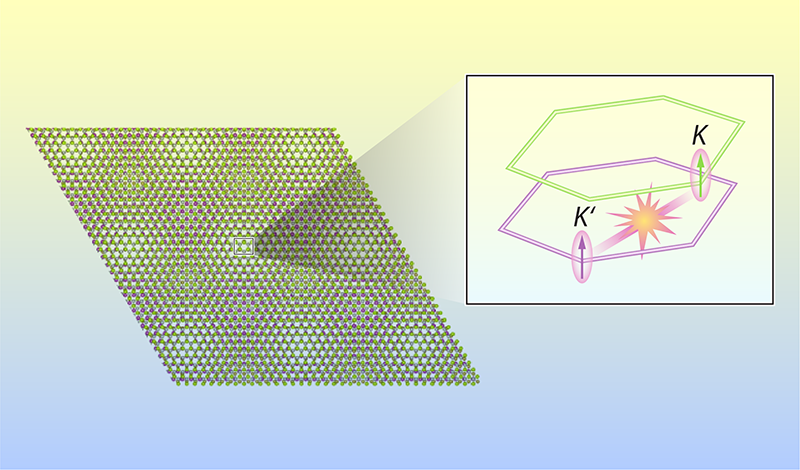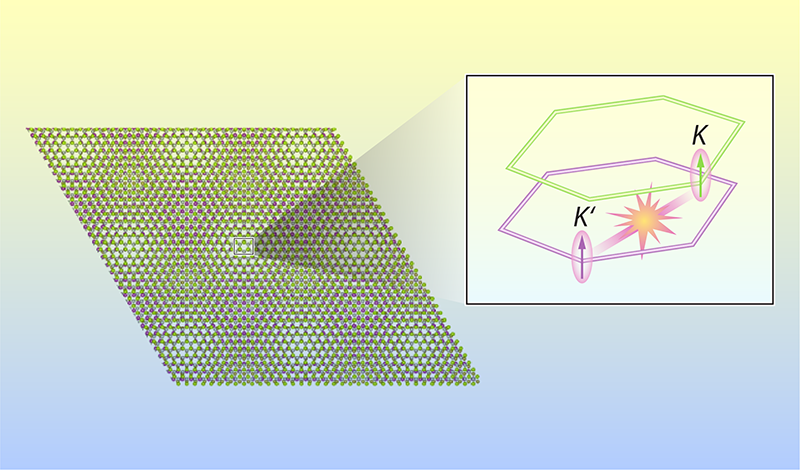Another Twist in the Understanding of Moiré Materials
If you take two overlapping tiled patterns and rotate one with respect to the other, new patterns will emerge. This motif has been used in art and architecture for millennia. Over the past 15 years, materials physicists have used a similar strategy to realize new material properties. In one implementation, two material monolayers with a hexagonal atomic lattice are overlaid with an angle between the two lattices, resulting in an additional long-range lattice structure known as a moiré pattern. In 2021, scientists observed the so-called quantum anomalous Hall (QAH) effect in such a twisted bilayer, formed of MoTe2 and WSe2 monolayers [1]. Now Zui Tao at Cornell University and colleagues have used optical spectroscopy to study the interaction between these two monolayers when they are in the QAH state [2]. The researchers show that theoretical predictions about this interaction are incorrect, demonstrating that there is still plenty to learn about these moiré materials.
Moiré materials exhibit a variety of interesting phenomena—such as superconductivity, magnetism, and, as shown in the past few years, the QAH effect [3]. This effect emerges when the material’s electronic structure is engineered to yield topologically protected states. The QAH effect is not just important for fundamental physics, though; materials displaying the effect exhibit dissipationless electrical conduction, which could be useful for energy-efficient electronics. The origin of the QAH effect in twisted graphene multilayers is well established. But it was surprising to observe the phenomenon in twisted bilayers of transition metal dichalcogenides (TMDs) such as MoTe2 and WSe2, where the bilayer’s electronic structure was thought to be described by a simple, existing theoretical model. The effect’s origin in these moiré materials is still not understood.
Important to the understanding of moiré materials is the concept of so-called valley physics. “Valleys” refer to local energy minima in the conduction band of a semiconductor material. The two valleys K and K ′ , named for their locations in momentum space, are not equivalent and have a spin polarization of up or down in materials with an asymmetric crystal structure, such as MoTe2 and WSe2. The K valley has a spin polarization of up in MoTe2 and of down in WSe2—and the K ′ valley has the opposite spin polarization. Such spin–valley coupling implies that twisted MoTe2/WSe2 bilayers can exist in one of two regimes. In the “valley-coherent” regime, the two layers have an aligned spin polarization, and electronic states are hybridized from the K valley of one layer and the K ′ valley of the other. In the “valley-polarized” regime, the two layers have an antialigned spin polarization, and states are hybridized from the same valley of the different layers.
Twisted graphene multilayers showing the QAH effect are valley polarized, and the theoretical expectation was that twisted MoTe2/WSe2 bilayers exhibiting the phenomenon would be as well [4]. To test this prediction, Tao and colleagues used an optical spectroscopy technique known as helicity-resolved reflectance-contrast spectroscopy. In this technique, circularly polarized light is applied to a material in the presence of an external magnetic field, and the material’s optical response is detected. If the material is spin polarized, its optical response will be different for the two possible helicities of the circularly polarized light. This difference is known as magnetic circular dichroism (MCD). For twisted MoTe2/WSe2 bilayers, the two layers have identical optical responses for the same spin polarization but are optically excited at different energies. This feature allowed the researchers to determine the spin polarization of each layer by measuring the bilayer’s optical response as a function of energy, magnetic-field strength, and light helicity.
Surprisingly, the MCD measurements revealed that, in the QAH state, the two layers had an aligned spin polarization, corresponding to the valley-coherent regime—as opposed to the expected valley-polarized one (Fig. 1). Furthermore, Tao and colleagues noted an interesting dependence of the MCD on the strength of the applied magnetic field: the magnitude of the MCD at 0 tesla (T) was only about half the value at a high field strength of above 6 T. The MCD probes the out-of-plane spin polarization, so this reduced value at zero field suggests that the bilayer’s spin polarization has an unanticipated in-plane component.
These unexpected results indicate that the current theory of the QAH state in this moiré material is insufficient. They also highlight the difference between TMD bilayers and graphene multilayers. Already, in the time between this study’s preprint and publication, experimentalists have revealed an additional topological phase in the same material [5], and theorists have proposed new models to explain the unusual topological phenomena found in moiré TMDs [6, 7]. The new information about valley coherence in twisted MoTe2/WSe2 bilayers will inevitably result in experiments to further elucidate the origin of the zero-field spin pattern and of the QAH effect. These bilayers have proven to be ideal systems for the study of the latter, which might provide insight into how to stabilize the phenomenon in other materials and at elevated temperatures.
References
- T. Li et al., “Quantum anomalous Hall effect from intertwined moiré bands,” Nature 600, 641 (2021).
- Z. Tao et al., “Valley-coherent quantum anomalous Hall state in AB-stacked MoTe2/WSe2 bilayers,” Phys. Rev. X 14, 011004 (2024).
- E. Y. Andrei and A. H. MacDonald, “Graphene bilayers with a twist,” Nat. Mater. 19, 1265 (2020).
- Y.-M. Xie et al., “Valley-polarized quantum anomalous Hall state in moiré MoTe2/WSe2 heterobilayers,” Phys. Rev. Lett. 128, 026402 (2022).
- W. Zhao et al., “Realization of the Haldane Chern insulator in a moiré lattice,” Nat. Phys. 20, 275 (2024).
- P. Mai et al., “1/4 is the new 1/2 when topology is intertwined with Mottness,” Nat. Commun. 14, 5999 (2023).
- Z. Dong and Y.-H. Zhang, “Excitonic Chern insulator and kinetic ferromagnetism in a MoTe2/WSe2 moiré bilayer,” Phys. Rev. B 107, L081101 (2023).





